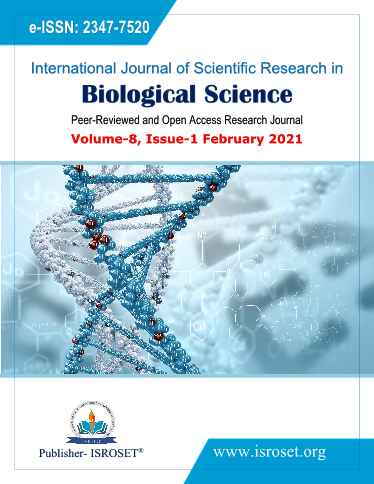Efficacy of Ocimum Sanctum against Alternaria Causing Diseases on Medicinal Plants
Keywords:
Antifungal, bio-fungicides, plant extractsAbstract
Ocimum sanctum extracts prepared in methanol were tested for their antifungal activity against Alternaria alternata isolated from two important medicinal plants including Aegle marmelos and Emblica officinalis. Leaf, shoot, and flowers of O. sanctum were screened individually for the antifungal activity. Disc diffusion method was conducted against Alternaria species for analyzing the antifungal properties of the medicinal plant. Zone of inhibition was measured for evaluating the antifungal activity of the methanolic extracts tested against the test fungal strain. Commercial fungicide at a similar protocol was taken as control. Although all the tested plant parts showed positive results of phytopathogenic growth inhibition, but the leaf extracts showed comparatively better effect than the flower and stem extracts. For both the diseased plants including A. marmelos and E. officinalis, leaf and flower extracts showed comparatively better results than stem. The consequences of using plant parts of O. sanctum as botanical fungicides against the fungal pathogen Alternaria have been discussed. The botanical fungicides could be a potential alternative to the commercial fungicides which cause damage to crop and plant development.
References
J. Singh, S. K. Bhatnagar, and A. Tomar, “Study on fungicidal effect of plant extracts on plant pathogenic fungi and the economy of extract preparation and efficacy in comparison to synthetic/chemical fungicides”, Journal of Applied and Natural Science, Vol. 11, Issue 02, pp. 333- 337, 2019.
GOI, “Economic survey 2010-11, Union Budget”. Statistical appendice: Economic survey, 2011.
D. Persley, “Diseases of fruit crops”, Brisbane: Department of primary industries, 1993.
S. A. J. Tarr, “Diseases of sorghum, sudan grass and broom corn”, The Commonwealth Mycological Institute, Kew, 1962.
P. Pattanayak, P. Behera, D. Das, and S. K. Panda, “Ocimum sanctum Linn. A reservoir plant for therapeutic applications: an overview”, Pharmacognosy review, Vol. 04, pp. 95–105, 2010.
S. Balakumar, S. Rajan, T. Thirunalasundari, and S. Jeeva, “Antifungal activity of Ocimum sanctum Linn. (Lamiaceae) on clinically isolated dermatophytic fungi”, Asian Pacific Journal of Tropical Medicine, Vol. 04, Issue 08, pp. 654-657, 2011.
S. Sharma, R. Singh, and B. Thakre, “Antifungal activity of leaf extracts of Ocimum sanctum against fungal pathogens”, International Journal of Current Microbiology and Applied Sciences, Vol. 08, Issue 04, pp. 1210-1214, 2019.
J. Guna Priya, K. Geetha Lakshmi, Niharika Sharma, D.Rajani, "A Comparative Study of Antioxidants and Antimicrobial activity in Vegetables, Leafy Vegetables and Spices," International Journal of Scientific Research in Biological Sciences, Vol.06, Issue.01, pp.80-85, 2019.
C. Perez, M. Paul, and P. Bazerque, “Antibiotic assay by agar well diffusion method”, Acta Biol Med Exp. Vol.15, pp. 113-115, 1990.
D. Singh and P. K. Chaudhuri, “A review on phytochemical and pharmacological properties of Holy basil (Ocimum sanctum L.)”, Industrial Crops and Products, Vol. 118: pp. 367–382, 2018.
S. Ojha, and M. Goyal, “Preliminary phytochemical screening of plant extracts prepared from traditional medicinal plants of Rajasthan”, Asian Journal of Research in Chemistry and Pharmaceutical Sciences, Vol. 07, Issue 03, pp. 819-823, 2019.
D. Chittoriya, M. Goyal, and S. Ojha, “Analysis of phytochemical constituents of selected medicinal weed plants occurring in central region of Rajasthan”, Asian Journal of Research in Chemistry and Pharmaceutical Sciences, Vol. 08, Issue 01, pp. 72-77, 2020.
P. J. Patil and J. S. Ghosh, “Antimicrobial Activity of Catharanthus roseus – A Detailed Study”, British Journal of Pharmacology and Toxicology, Vol. 01, Issue 01, pp. 40-44, 2010.
Downloads
Published
How to Cite
Issue
Section
License

This work is licensed under a Creative Commons Attribution 4.0 International License.
Authors contributing to this journal agree to publish their articles under the Creative Commons Attribution 4.0 International License, allowing third parties to share their work (copy, distribute, transmit) and to adapt it, under the condition that the authors are given credit and that in the event of reuse or distribution, the terms of this license are made clear.







